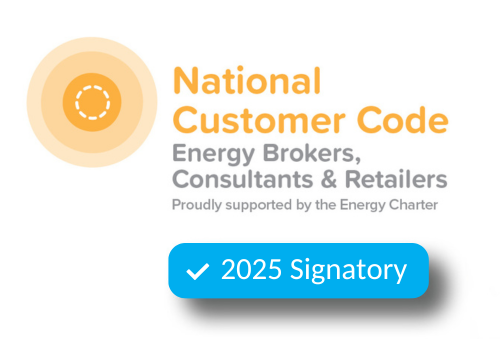Get your business started on the path to Net Zero

What is Net Zero?
Net Zero or "net zero emissions" refers to a point where a balance between greenhouse gas emissions produced and taken out of the atmosphere has been achieved.
The Australian government has set a target of reaching Net Zero by 2050 and encourages businesses to implement energy efficiency measures, use renewable energy measures, optimise supply chains, and to offset the remaining emissions by buying carbon credits.
Why is Net Zero Compliance Important
Looking at the big picture, it’s all about a global response to human-induced climate change.
With the growing concern over global warming, countries came together on 22 April 2006 to sign the Paris Climate Accords, an international treaty that aims to reduce the effects of climate change. Australia is one of the signatories of this agreement.
To do its part, the Australian government has set a target to achieve net zero emissions by 2050, contribute towards stabilising climate change, and help build a better future for everyone.
Businesses may also reap some benefits from taking steps towards sustainability and net zero compliance including:
-
Cost Savings: While a significant initial investment is likely, businesses can recoup this and reduce costs in the long run by controlling and optimising energy consumption.
-
Improved brand reputation: Sustainability is a growing priority among consumers and investors. Committing to a sustainable approach can help businesses gain access to the eco-conscious market and new opportunities.
-
Supply chain resilience: Switching to sustainable practices can help businesses get ahead of challenges that go with climate change, resource shortage, and changes in relevant government regulations.
-
Improved operational efficiency and innovation: The need for compliance can spur businesses to develop their systems and processes to become more efficient and in tune with the goals of Net Zero, whether by creating their own or adopting new procedures and technology.
-
Employee motivation and engagement: People are more driven to work with companies whose ethics and values closely mirror their own. Committing to a net-zero approach can attract like-minded talent and boost satisfaction and retention.
-
Climate change risk management and mitigation: Businesses that integrate sustainable strategies are better placed to handle climate change-related challenges like extreme weather and policy changes, among others.
-
Long-term business viability: Businesses committed to transitioning to net-zero practices are likelier to be more resilient when faced with the challenges of the changing environment and its effects.
-
Access to applicable government programs: The federal and state governments have set up initiatives to help businesses incorporate renewable energy systems and energy efficiency improvement plans. Some examples over the years are the Clean Energy Finance Corporation (CEFC), state government grants and various energy efficiency programs.
3-steps toward Net Zero:

1. Measure
Quantify your Greenhouse Gas emissions (GHG) within the selected boundaries of your system to set a base level for comparisons. To achieve this, your organisation needs to:
-
Establish the emissions boundary, identifying the relevant sources within each scope. The boundary refers to the legal composition of the company and whether the company has direct control over the sources of the emissions.
-
Set a base year, which will serve as a starting point for emissions comparisons.
-
Collect data on identified emissions sources: Measure your emissions or use conservative estimates when data is not available.
-
Calculate the total carbon count attributable to the organisation
Leading Edge Energy can assist you with calculating your system accountability.
What are the emissions boundaries?
These are the limits set on the amount of GHG emissions that can be released into the atmosphere without compromising climate-related goals.
These are classified into:
-
Scope 1: Direct GHG Emissions
These are produced by sources owned or controlled by the company like when fossil fuels are burned or during certain production processes.
-
Scope 2: Energy Indirect Emissions
These result from the generation of purchased energy from a provider, consumed by the company. Some examples are the emissions produced by electricity-powered heating and cooling systems.
-
Scope 3: Other indirect GHG emissions
An optional reporting category, these are a consequence of the company’s activities but from sources not owned or controlled by the company. Examples are emissions from the production and distribution of energy sources bought and used by the company.
2. Reduce
Once your emissions are quantified, you need to plan and implement different measures to minimise emissions. Leading Edge Energy can guide your organisation when planning and implementing measures related to:
-
Energy Efficiency: We analyse your energy use and identify opportunities to reduce your energy consumption, in turn reducing emissions and energy costs.This can be achieved through a combination of behavioural change as well as technological improvements at your facilities.
This can be achieved through a combination of behavioural change as well as technological improvements at your facilities.
-
Renewable energy generation: Leading Edge Energy will help cut through the noise by presenting the best workable options for your business so you can make a well-informed and confident decision.
Our service includes system design, specifications, and tender outcome reporting. We also evaluate your current PV system and advise on whether battery storage could be a useful addition to reduce peak energy charges and demand/capacity charges.
-
Green energy purchase: Another way to reduce your organisation’s emissions is by purchasing energy that comes from renewable sources, such as large solar plant generators, wind farms, and hydroelectric plants, to name a few examples.
Our Leading Edge Energy experts can help you find service providers with the best deals for your organisation.
3. Offset
The last step is to acquire carbon offset units to compensate for your remaining emissions, investing in projects that reduce, remove, or capture emissions from the atmosphere.
We can help you select the most cost-effective options for your business.
Carbon neutrality claim and certification
Leading Edge Energy can also guide your organisation with the fulfilment of specific Standards, to claim carbon neutrality.
You can also go one step further, and obtain carbon neutral certification.
Some of the benefits of certification are:
-
You are entitled to use the trademark/logo to demonstrate your commitment,
-
You can claim carbon neutrality in marketing and other communications,
-
You show your company is an active actor that pursues a better future,
-
You can differentiate from your competitors, and attract new customers and/or stakeholders,
-
You can gain a better position regarding future carbon policies.

Net Zero Planning
Reaching Net Zero emissions sounds simple - removing as many greenhouse gases from the atmosphere as is put in over a given year.
But the reality is that a lot of planning needs to be done before reaching this lofty milestone. Businesses must report their emissions, indirect emissions, and scope 3 emissions resulting from their client’s actions further down the product or service journey.
Once an emissions reporting period has been concluded, we can then help you cut back on greenhouse emissions by increasing energy efficiency, sourcing clean energy, and investing in afforestation, vegetation rehabilitation and other projects that will help your business achieve a neutral carbon footprint.
What this means for our clients:
-
We help you set up a credible and doable roadmap to net zero emissions
-
We provide actionable advice to reduce emissions and save money from Day 1
-
You are awarded with a certified Net-Zero badge
-
You win the hearts and minds of an increasingly conscientious market
Carbon Offset Purchasing
When done correctly, carbon offset credits are a real and credible way for businesses to reduce their carbon footprint legitimately. The process involves purchasing carbon offsets generated by projects that remove greenhouse gases from the atmosphere.
These can include newly planted forests, forest regeneration projects, flora and fauna regeneration initiatives and many others.
However, it can be easy to fall into the “Greenwashing” trap if correct due diligence is not done. In such cases, businesses may invest in dud projects that do little or nothing to reduce greenhouse gas removal.
What this means for our clients:
-
We provide correct and proper advice about navigating the carbon credit market
-
We help you perform proper due diligence into the validity and viability of project investment
-
We determine another path to achieving net zero emissions
-
You win the hearts and minds of an increasingly conscientious market
Is your business striving for Net Zero?
Surveys demonstrate that many consumers are more willing to give their business to companies that take action to safeguard the environment and climate change.
The United Nations is also pushing for companies that achieve net zero to be rewarded financially and those that do not to be penalised.
The Australian Government has also kickstarted the discussion, with the Treasurer saying that companies that do not strive to reach net zero or better, would face “material risks.”
If your business is striving for net zero compliance, you have come to the right place. Drop us an email or call us for an obligation-free consultation.
Interested in getting personalised energy efficiency and cost-reduction advice for your business? Your People in Power are ready to help.
Are you ready to save on business energy costs?
Get Started
Leading Edge Energy is proud to be a signatory of the National Customer Code for Energy Brokers, Consultants and Retailers.